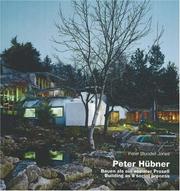| Listing 1 - 10 of 27 | << page >> |
Sort by
|
Book
ISBN: 0856709271 0856709298 0312061919 0312061927 9780856709296 9780856709272 9780312061913 9780312061920 Year: 1991 Publisher: London Academy Editions
Abstract | Keywords | Export | Availability | Bookmark
 Loading...
Loading...Choose an application
- Reference Manager
- EndNote
- RefWorks (Direct export to RefWorks)
Architecture --- Ahrends, Steffen --- Ahrends Burton Koralek (ABK) --- Great Britain --- Ahrends, Peter --- Burton, Richard --- Koralek, Paul --- Burton Richard --- architectuur --- twintigste eeuw --- Ahrends Burton and Koralek --- Ahrends Peter --- Koralek Paul --- Architectural design. --- Architecture. --- Burton, Richard, --- Koralek, Paul, --- Ahrends, Burton, and Koralek. --- Great Britain. --- Ahrends, Peter. --- Ahrends Burton Koralek [Dublin] --- Ahrends Burton, and Koralek --- Architecture - 20e siècle --- Architecture - Grande-Bretagne - 20e siècle --- Burton, Richard, - 1933 --- -Koralek, Paul, - 1933 --- -Architecture --- -Ahrends, Peter --- -Architectural design.

ISBN: 0900406577 9780900406577 Year: 1978 Publisher: London Gordon Fraser
Abstract | Keywords | Export | Availability | Bookmark
 Loading...
Loading...Choose an application
- Reference Manager
- EndNote
- RefWorks (Direct export to RefWorks)
architectuur --- architecture [discipline] --- Architecture --- Scharoun, Hans --- Scharoun, Hans, --- twintigste eeuw --- Duitsland --- architecten --- scholen --- concertgebouwen --- Scharoun Hans --- architects --- Germany --- Scharoun, Hans, - 1893-1972

ISBN: 0714828777 Year: 1995 Publisher: London Phaidon
Abstract | Keywords | Export | Availability | Bookmark
 Loading...
Loading...Choose an application
- Reference Manager
- EndNote
- RefWorks (Direct export to RefWorks)
Architectural drawing --- Dessin d'architecture --- Scharoun, Hans, --- Scharoun, Hans --- Architecture, Modern --- Architecture --- Drawing, Architectural --- Plans --- Architectural design --- Communication in architectural design --- Drawing --- Mechanical drawing --- History
Book
ISBN: 3901174362 Year: 1998 Publisher: Graz Haus der Architektur
Abstract | Keywords | Export | Availability | Bookmark
 Loading...
Loading...Choose an application
- Reference Manager
- EndNote
- RefWorks (Direct export to RefWorks)
Architecture --- Avant-garde (Aesthetics) --- History --- 72.036 --- 1976-2000 --- Oostenrijk --- Graz --- Architectuur ; Oostenrijk ; Graz ; 1980-1997 --- 72(436) --- 72.038 --- Twintigste eeuw (architectuur) --- 20ste eeuw (architectuur) --- Architectuur ; Oostenrijk --- Architectuurgeschiedenis ; 1950 - 2000 --- Aesthetics --- Modernism (Art) --- Architecture, Western (Western countries) --- Building design --- Buildings --- Construction --- Western architecture (Western countries) --- Art --- Building --- Design and construction --- Architecture, Primitive

ISBN: 0714839760 9780714839769 Year: 2006 Publisher: London New York : Phaidon,
Abstract | Keywords | Export | Availability | Bookmark
 Loading...
Loading...Choose an application
- Reference Manager
- EndNote
- RefWorks (Direct export to RefWorks)
Erik Gunnar Asplund (1885-1940) produced buildings of extraordinary grace and poetry in his native Sweden. Among his best known works are the pavilions at the 1930 Stockholm Exhibition, the Stockholm Library (1928) and the Woodland Chapel (1920). This book celebrates the life and work of Asplund, a contemporary of Walter Gropius and Le Corbusier, who was recognized for his unique blend of Classical, Modernist and Vernacular architecture. Asplund's achievements are amply demonstrated through masterpieces that lasted throughout his career, such as the Gothenburg Law Courts (1913-1937) and the Enskede Cemetery (1915-1940), a collaboration with Sigurd Lewerentz. As a result of detailed and specialist research, each project is examined through a comprehensive survey of original and archival drawings from Asplund's office, offering a comprehensive and authoritative guide to his oeuvre. In addition to major buildings, smaller built and unbuilt projects are also explored, such as the architect's own summer house at Stennäs (1938) and the crematoria at Kviberg and Skövde (1940). Peter Blundell Jones' study provides an expert overview of Asplund and his legacy of Scandinavian Modernism. Generously illustrated throughout with key plans, sketches, archival drawings and unseen special photography, this book presents a unique and essential evaluation of Asplund for anyone interested in the subject of architecture during the first half of the twentieth century.
Asplund, Gunnar, --- Critique et interprétation --- Architects --- Architecture --- Architecture, Modern. --- History --- Asplund, Erik Gunnar --- Asplund, Erik Gunnar, --- Erik Gunnar Asplund 1885-1940 (° Stockholm, Zweden) --- Architectuur ; Zweden ; modernisme ; E.G. Asplund --- Architectuur ; Skandinavisch Classicisme --- 72.07 --- 72.037 --- 72.036 --- 72.036 Moderne bouwkunst. Architectuur van de 20e eeuw --- Moderne bouwkunst. Architectuur van de 20e eeuw --- Architecten. Stedenbouwkundigen A - Z --- Architectuurgeschiedenis , 1900 - 1950 --- Architecture, Modern --- Modern architecture --- Professional employees --- Asplund, E. G. --- Criticism and interpretation. --- Critique et interprétation --- Suède --- 1900-1945 --- Modernisme (esthétique) --- Architecte --- Asplund, Erik Gunnar, - 1885-1940

ISBN: 3764360461 9783764360467 Year: 2000 Publisher: Basel Birkhäuser
Abstract | Keywords | Export | Availability | Bookmark
 Loading...
Loading...Choose an application
- Reference Manager
- EndNote
- RefWorks (Direct export to RefWorks)
Architectes allemands --- Behnisch, Günter, --- Behnisch und Partner --- Architecture --- -Behnisch, Günter --- Architecture, Western (Western countries) --- Building design --- Buildings --- Construction --- Western architecture (Western countries) --- Art --- Building --- Design and construction --- Behnisch, Gunter --- Behnisch & Partner (Firm) --- Behnisch und Partner (Firm) --- Behnisch, Behnisch & Partner --- Architecte --- Architecture organique --- Bâtiment public --- Déconstructivisme --- Stade --- Behnisch, Günter --- Allemagne --- Munich --- History --- Behnisch, Günter,
Book
ISBN: 0714836281 Year: 1997 Publisher: London Phaidon
Abstract | Keywords | Export | Availability | Bookmark
 Loading...
Loading...Choose an application
- Reference Manager
- EndNote
- RefWorks (Direct export to RefWorks)
Hans Scharoun 1893-1972 (° Bremen, Duitsland) --- Architectuur 20ste eeuw Hans Scharoun --- Functionalisme --- Architectuur Expressionisme --- 72.07 --- Architecten. Stedenbouwkundigen A - Z --- Hans Scharoun --- Scharoun, Hans, --- Architectuur ; 20ste eeuw ; Hans Scharoun --- Architectuur ; Expressionisme --- Architectural drawing --- Architecture, Modern --- architectuur 20e eeuw --- architecten --- 72.071 --- buitenlandse architecten
Book
ISBN: 1472577493 1472577507 9781472577498 9781472577504 9781472577474 Year: 2020 Publisher: London, England : London, England : Bloomsbury Academic, Bloomsbury Publishing,
Abstract | Keywords | Export | Availability | Bookmark
 Loading...
Loading...Choose an application
- Reference Manager
- EndNote
- RefWorks (Direct export to RefWorks)
"Architecture and Ritual explores how the varied rituals of everyday life are framed and defined in space by the buildings which we inhabit. It penetrates beyond traditional assumptions about architectural style, aesthetics and utility to deal with something more implicit: how buildings shape and reflect our experience in ways of which we remain unconscious. Whether designed to house a grand ceremony or provide shelter for a daily meal, all buildings coordinate and consolidate social relations by giving orientation and focus to the spatial practices of those who use them. Peter Blundell Jones investigates these connections between the social and the spatial, providing critical insights into the capacity for architecture to structure human ritual, from the grand and formal to the mundane. This is achieved through deep readings of individual pieces of architecture, each with a detailed description of its particular social setting and use. The case studies are drawn from throughout architectural history and from around the globe, each enabling a distinct theoretical theme to emerge, and showing how social conventions vary with time and place, as well as what they have in common. Case studies range from the Nuremberg Rally to the Centre Pompidou, and from the Palace of Westminster to Dogon dwellings in Africa and a Modernist hospital. In considering how all architecture has to mesh with the habits, beliefs, rituals and expectations of the society that created it, the book presents deep implications for our understanding of architectural history and theory. It also highlights the importance for architects of understanding how buildings frame social space before they prescribe new architectural designs of their own. The book ends with a recent example of user participation, showing how contemporary user interest and commitment to a building can be as strong as ever."--
Buildings --- Edifices --- Halls --- Structures --- Architecture --- Building --- Building materials --- Standards. --- Built environment --- Architecture and society. --- Architecture and sociology --- Society and architecture --- Sociology and architecture --- Social aspects. --- Social aspects --- Human factors
Book
Year: 1995 Publisher: London: Phaidon,
Abstract | Keywords | Export | Availability | Bookmark
 Loading...
Loading...Choose an application
- Reference Manager
- EndNote
- RefWorks (Direct export to RefWorks)

ISBN: 9783932565021 Year: 2007 Publisher: Stuttgart : Menges,
Abstract | Keywords | Export | Availability | Bookmark
 Loading...
Loading...Choose an application
- Reference Manager
- EndNote
- RefWorks (Direct export to RefWorks)
Architecture and society. --- Group work in architecture. --- Organic architecture. --- Hübner, Peter, --- Criticism and interpretation.
| Listing 1 - 10 of 27 | << page >> |
Sort by
|

 Search
Search Feedback
Feedback About UniCat
About UniCat  Help
Help News
News